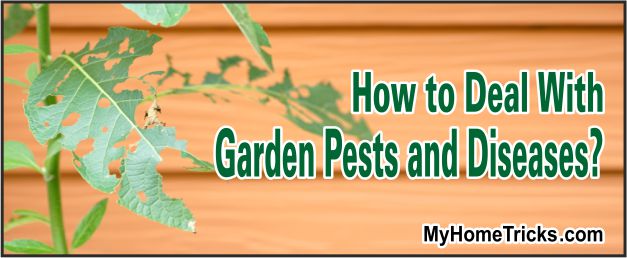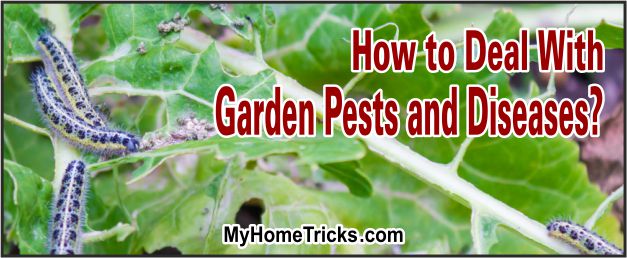Deal With Garden Pests and Diseases
The article provides some useful tips on how to deal with common plant diseases and pests. Powdery mildew, earwigs, toadstools, spider mites, botrytis, aphids, viruses, clubroot, foot, and root rot, and scab are some of the most common problems that gardeners face. The author suggests practical and effective solutions such as pruning to improve air circulation, removing infected plant debris, using suitable fungicides and insecticides, avoiding overwatering, and using sterilized soil mix. It is essential to maintain good hygiene practices to prevent the spread of diseases and to choose resistant cultivars wherever possible. By following these guidelines, gardeners can keep their plants healthy and beautiful.
Gardening can be a relaxing and rewarding activity, but dealing with pests and diseases can be challenging. Every gardener is likely to encounter pests and diseases at some point, which can have a devastating effect on plants. However, identifying and addressing these issues early can prevent harm to your garden. In this article, we will discuss some of the most common garden pests and diseases and how to deal with them effectively.
Garden Pests and Diseases
Gardening is a popular and rewarding activity, but it can be challenging to deal with pests and diseases that can damage your plants. Here are some tips for managing common garden problems.
As a gardener, it is essential to recognize and differentiate between different garden pests and diseases. Some pests and diseases can cause serious problems only if the plant is already under attack or badly stressed. On the other hand, some pests can cause significant damage and devastation to your garden plants. The following list can help you identify major problems and learn how to address them effectively.
Slugs and Snails:
Both these pests feed mainly at night and after rain. Smooth-edged holes appear on the foliage, stems, and petals. Both pests may tunnel into corms, bulbs, and tubers, making large holes. Silvery slime trails are often found nearby. To control slugs, use nematodes. Cultivate the soil to expose eggs, and remove debris. Reduce the use of organic mulches. Lure slugs to inverted citrus peels, collect the peels and discard.
Caterpillars:
Many garden plants are attacked by caterpillars, which are the larvae of butterflies and moths. Leaves, soft stems, and occasionally flowers develop holes as they are eaten. Some caterpillars spin a fine web around the leaves. Pick off the caterpillars. Prune out damaged stems and heavily webbed areas. Spray with the biological control Bacillus tburingiensis or with a suitable pesticide.
Greenhouse Whiteflies:
Greenhouse whiteflies are most common in greenhouses but may also be found outside in hot weather. Leaves are discolored and distorted and may be covered with sticky excreta, which attracts black sooty mold growth. Introduce the parasitic wasp Encarsia formosa into greenhouses and conservatories. Alternatively, spray with insecticidal soaps or other insecticides.
Weevils:
Adult beetles cause notching around leaf edges. The white grubs attack many plants, particularly those in containers. They eat and tunnel into roots, tubers, and corms. In mid-spring or early autumn, biological control drenches of nematodes into warm, moist soil. Gather and destroy adult beetles and grubs.
Rust:
Various fungi are responsible for rust infections. They are most severe in damp or moist weather and on soft, lush growth. Orange, yellow, or brown spots appear on leaves, mostly on the lower surface. The upper surface may have yellow blotches. Remove infected leaves promptly. Improve air circulation around the plants. To decrease humidity, avoid wetting the foliage. Spray with a suitable fungicide.
Leaf Spot:
Various bacteria and fungi cause leaf spots. If caused by bacteria, spots may be irregular with a yellow edge. Fungal spots have concentric rings and an area of tiny fungal fruiting bodies. Black, brown, or gray spots may cover the leaves. Most leaf spots do not cause serious problems and may develop only on plants that are in poor condition. Remove badly infected leaves, and improve the plant’s growing conditions. Spray with a suitable fungicide for fungal leaf spots.
Powdery Mildew:
Powdery mildew causes a white, powdery layer of fungal growth to appear, usually in distinct patches or spots, which then coalesce. A few mildew are pale brown and felty. Leaves, stems, and flowers may be attacked, and may wither and die. Powdery mildew thrives in the humid air. Prune to improve air circulation and keep plants well-watered and mulched. Avoid wetting leaves. Spray with a suitable fungicide.
Earwigs:
Many plants are attacked by these pests, particularly dahlias, chrysanthemums, clematis, peaches, and certain annuals. Young leaves and petals are eaten, especially during the summer. In extreme cases, a plant can be severely damaged. Make traps with rolled-up corrugated cardboard or flower pots stuffed with straw. Gather and destroy the pests. Alternatively, spray at dusk with an insecticide.
Toadstools:
Toadstools are usually seen in lawns in the autumn, especially during mild, damp spells. Toadstools are usually short-lived and rarely survive the first frost. They may form “fairy rings,” which cause the grass to become discolored. If the grass is unharmed, simply brush off the toadstools as soon as they appear, preferably before their caps open. If they reappear, they may be growing on buried organic debris, such as old tree roots. Dig these out.
Spider Mites:
Several species of spider mites occur in gardens and greenhouse plants. A common and troublesome species is the two-spotted or greenhouse spider mite. In severe cases, leaves may turn brown and die. Fine webbing may appear on affected plants. Control spider mites with predatory mites. Allow adequate ventilation and damp down frequently. Spray with insecticidal soap or miticide.
Botrytis:
Many plants are susceptible to this fungus. Fuzzy, gray patches develop on infected areas. Plant tissue becomes discolored and deteriorates, and there may be extensive dieback. White or yellow circles appear on tomato skins. Clear out all plant debris. Remove and destroy infected tissue promptly. Avoid injuring the plants, and improve air circulation around them by pruning. If necessary, spray with a suitable fungicide.
Aphids:
Aphids feed by sucking sap and may cause plant parts to become discolored and distorted. Their sticky excreta may encourage the growth of black sooty mold. Aphids can be many colors; some are covered with white, waxy wool. Natural or introduced predators and parasites may help to reduce numbers. Spray with a strong stream of water from a hose to dislodge them or with insecticidal soap or insecticide.
Viruses:
Viruses have a diverse host range and can cause various symptoms, including stunting, poor growth, leaf yellowing, distortion, and flower color changes. They are spread by handling or mechanical injuries and pests like aphids, thrips, and nematodes. To prevent viruses, avoid damaging plants, disinfect pruning tools frequently, and control virus-carrying pests. Remove infected plants promptly.
Clubroot:
Clubroot affects many brassicas and some ornamentals, causing distorted and swollen roots, discolored foliage, and stunted growth. To prevent clubroot, improve soil drainage and add lime to discourage the slime mold responsible for the disease. Raise plants in individual pots and choose resistant cultivars if possible.
Foot and Root Rot:
Bedding plants, seedlings, beans, cucumbers, tomatoes, and peas are particularly susceptible to soil- or waterborne fungi that cause discoloration of stem bases, poor growth, and wilting. To prevent this disease, use sterilized commercial soil mix, clean trays and pots, and tap water. Do not overwater or crowd plants, and water seeds and seedlings with a copper-based fungicide. Remove affected plants immediately.
Scab:
Scab is a common disease that affects apples, pears, and Pyracantha, causing gray or black, scabby patches on leaves and fruit, as well as fruit distortion and leaf puckering. To prevent scabs, avoid overhead watering, rake up and dispose of affected leaves, and prune out infected shoots. Spray with a suitable fungicide.
Codling Moths:
The larvae of codling moths attack apples and pears, causing holes in ripe fruit. Hang pheromone traps in trees from late spring to midsummer to catch male moths and reduce the number of fertilized eggs. Spray with a suitable pesticide.
Cabbage Root Flies:
Many brassicas may be attacked by this pest, causing seedlings to die, wilt, and become discolored. Larvae tunnel into the roots of crops, causing damage. To prevent cabbage root flies, place collars around the base of each plant when transplanting or dust transplanted brassicas and seed rows with a suitable soil insecticide.
Carrot Rust Flies:
Carrot rust flies attack carrots, celery, and parsley, causing rust-brown lesions on roots and plants, and discolored foliage. To prevent this pest, erect a plastic barrier around crops to keep out female flies or protect a whole crop with a row cover. Avoid handling crops and treat seed rows with a suitable insecticide.
Flea Beetles:
Seedlings of brassicas, leafy vegetables, and other plants are vulnerable to flea beetles, which make numerous holes in the upper surfaces of leaves. To prevent this pest, clean up debris thoroughly to avoid damage, use sticky traps, warm soil before sowing seeds, and water regularly to encourage rapid, strong growth. Use a suitable insecticide.
Wireworms:
Many plants, particularly potatoes, and other root crops may be attacked by wireworms. Perennials, annuals, seedlings, and bulbous plants can also be damaged by these pests. As wireworms tunnel into their roots, young plants may wilt, wither, and die. These pests are most likely to be found in recently cultivated soil or in an area that has recently been converted from grass. To control wireworms, bury carrot and potato pieces as bait and lift root crops as early as possible. Apply a suitable insecticide to infested soil.
Peach Leaf Curl:
Peaches, nectarines, and ornamental and edible almonds can be attacked by this fungus. The affected leaves pucker, become blistered and swollen, and then turn red or purple. As spore layers develop on the surfaces, the leaves turn white. To prevent the air- or waterborne spores from spreading, erect a plastic shelter over susceptible trees. Pick off affected leaves and spray with a copper fungicide in midwinter, and again two weeks later. Finally, spray again when the leaves fall.
Conclusion:
Dealing with pests and diseases in your garden is an important part of maintaining healthy plants and a thriving garden. By understanding the different types of pests and diseases that can affect your plants and taking proactive steps to prevent and control them, you can avoid costly and time-consuming problems down the line. Whether it’s practicing good hygiene, using appropriate fertilizers and fungicides, or simply choosing resistant plant varieties, there are many ways to keep your garden healthy and productive. With a little knowledge and effort, you can enjoy the beauty and bounty of your garden all season long.








